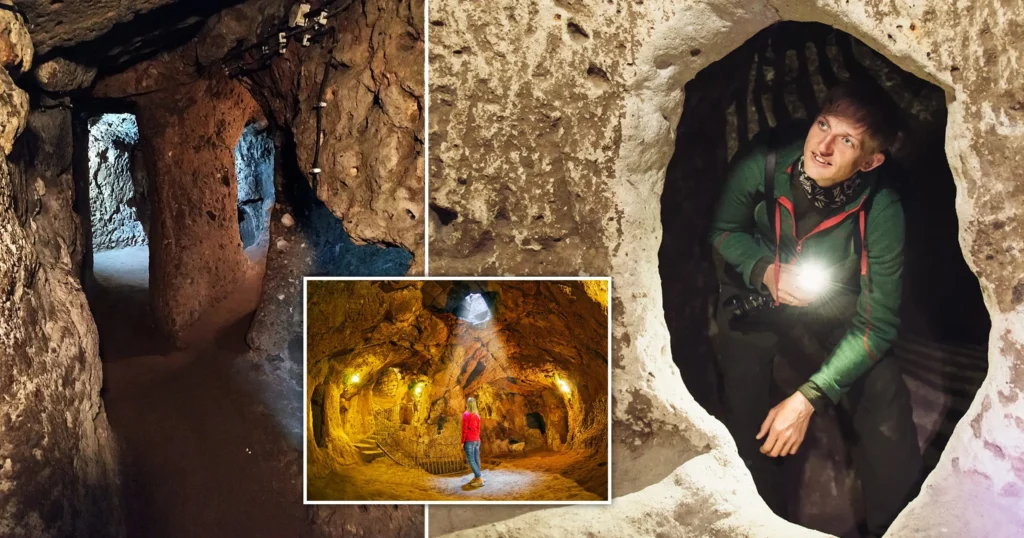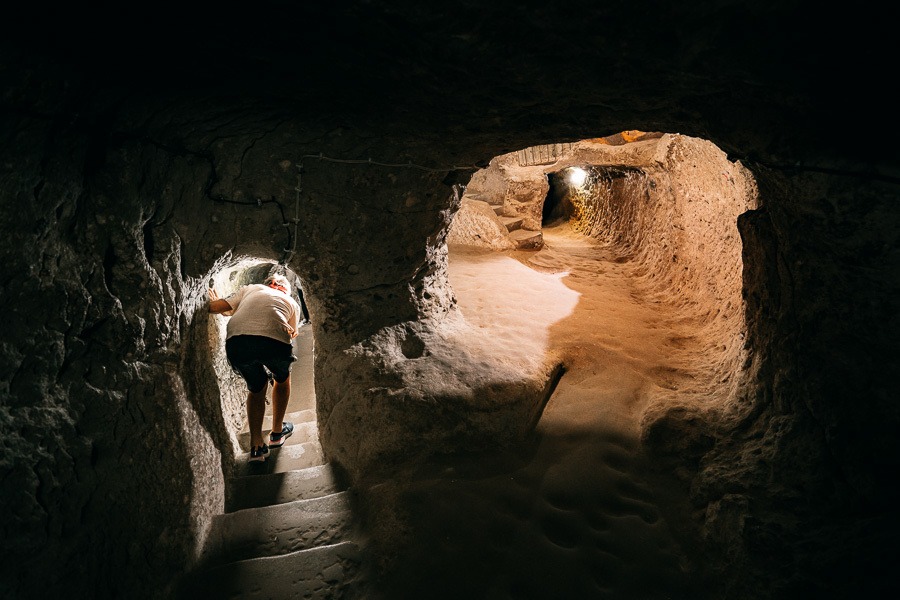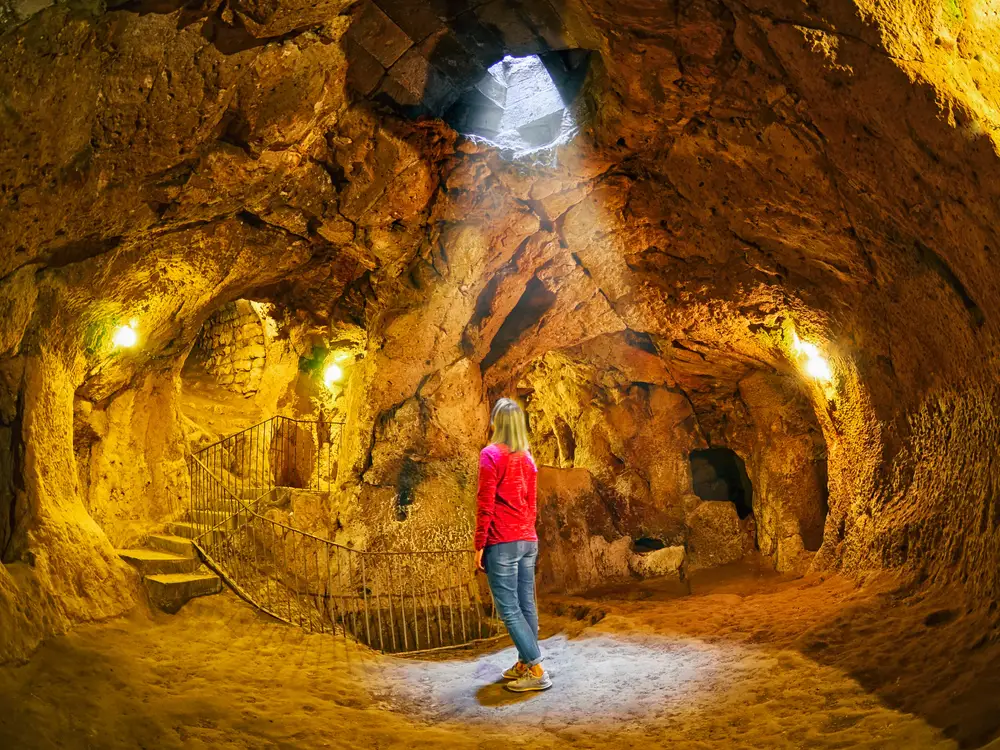Imagine you’re knocking down a basement wall, expecting maybe a little more space, or, if you’re unlucky, some plumbing issues. But no—what you discover instead is a tunnel leading to an ancient underground city capable of housing 20,000 people. That’s exactly what happened to a man in Turkey in 1963. What he unearthed wasn’t just an architectural quirk or a forgotten relic—it was the entrance to Derinkuyu, an expansive, fully equipped underground city that dates back to the 7th or 8th century BCE.
The Unbelievable Discovery of Derinkuyu
It’s like a scene out of a movie: you take a sledgehammer to your basement wall, and suddenly, you’re transported back thousands of years into an entire hidden city. The very fact that this place existed unnoticed for centuries is mind-blowing. Derinkuyu is massive, spanning 172 square miles (about 445 square kilometers) beneath the surface. The discovery brought to light a city complete with homes, shops, stables, temples, and schools—all of it entirely underground.

The city itself was abandoned long ago, which, honestly, is probably a good thing for the homeowner. Who wants to discover an entire civilization under their house, still inhabited?
The tunnels and rooms are extensive, and this network was designed for long-term living. It wasn’t just some quick shelter; it was a place where people could—and did—live for extended periods. The city had ventilation shafts to ensure fresh air reached its deepest levels, allowing its inhabitants to survive indefinitely underground if needed.
Why Build an Underground City?
At first glance, it’s easy to wonder why anyone would want to live beneath the earth. But think about it: this was a time when invasions, wars, and raids were constant threats. Being above ground meant you were an easy target for enemies. By living underground, people could quite literally vanish from the sight of those seeking to cause harm. Derinkuyu wasn’t just a city; it was a fortress hidden in plain sight.
Initially, it seems the city began as a series of underground cellars and food storage rooms. Given the soft volcanic ash deposits in the region, digging underground was relatively easy. Not only did this underground setup protect food from spoiling (thanks to consistent temperatures and humidity), but it also laid the groundwork for the massive expansion that followed.
Over the centuries, the city continued to grow. What started as a few cellars eventually became a sprawling underground metropolis, with homes and businesses carved deep into the earth. When external threats became too great—be it war, natural disasters, or otherwise—this hidden city served as a sanctuary for thousands.
The Benefits of Living Underground
Living underground might sound claustrophobic, but Derinkuyu was designed with the comfort and safety of its inhabitants in mind. The soft ground made it easier to carve out new rooms and spaces as the population grew. And with well-disguised entrances, the city was able to hide itself from potential invaders.
The ventilation system was another remarkable feature. With shafts bringing in fresh air, the city could have been sealed off indefinitely from the outside world without anyone suffering from a lack of oxygen. It wasn’t just a temporary hideout—it was a self-sustaining environment.
One of the fascinating things about Derinkuyu is that it’s not the only underground city in the region. There are numerous others, though none quite as large. It’s believed that these underground spaces were expanded and enhanced during times of crisis, like invasions. For the people who lived there, it must have felt like an impenetrable fortress—safe, hidden, and entirely self-contained.

What Life Might Have Been Like in Derinkuyu
Picture life in Derinkuyu during its peak. While the thought of living underground might seem dreary, this city was bustling with life. Imagine walking through tunnels lined with shops and homes, passing by stables where animals were kept. The underground layout allowed for a sense of normalcy even when external circumstances were dire.
The city wasn’t just a cramped bunker. It was a sophisticated settlement, with temples for worship, schools for education, and homes where families lived their day-to-day lives. There were communal areas, and while it wasn’t a sprawling metropolis like New York or Paris, it was certainly large and complex for its time.
The Importance of Derinkuyu in History
Derinkuyu offers a fascinating glimpse into ancient life and survival strategies. It’s not just a relic of the past—it’s a symbol of human ingenuity. The people who built and expanded this city were responding to the pressing needs of their time. Threatened by war and uncertainty, they created an underground refuge that allowed them to continue their lives in relative safety.
In a sense, Derinkuyu represents the human spirit’s determination to survive. When the world above was too dangerous, they went below. Today, it stands as one of the most incredible archaeological discoveries ever made—a testament to the lengths people will go to protect themselves and their communities.
Lost Picasso Found in a Basement: Junk Dealer’s Discovery Now Worth $6.6 Million
Derinkuyu Today: A Living Monument
Derinkuyu has since become a tourist destination, offering visitors the chance to walk through its winding tunnels and explore the rooms and spaces that once housed thousands. It’s a marvel of ancient architecture, showcasing the sophisticated design and careful planning that went into its construction.
This underground city, like many others around the world, reminds us that history isn’t just found in books or museums—it’s hidden beneath our feet. The story of Derinkuyu is a reminder that some of the most incredible discoveries are yet to be made, often in the least expected places.
As for the man who found it—can you imagine his reaction? He thought he was just knocking down a wall. Instead, he knocked down the barrier between the present and the past, unveiling one of the world’s greatest hidden wonders.

